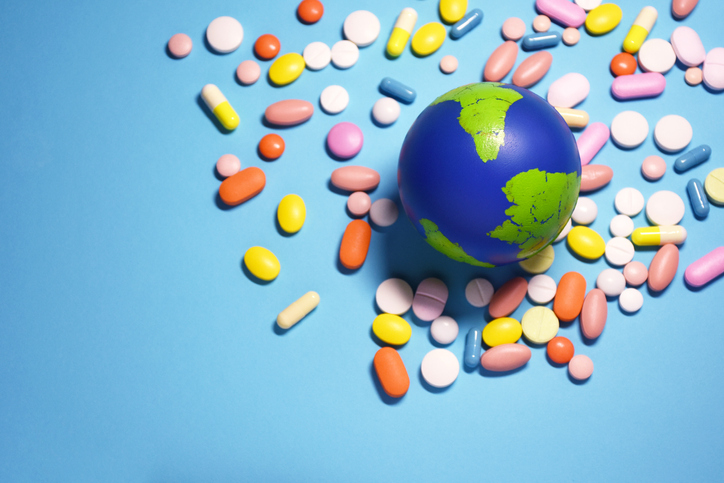Most people might not guess that pills (or creams, patches, and inhalers, for that matter) have a big impact on the environment — but they do.
Climate change is leading to noticeable effects on the environment, as well as to consequences for our health, such as rising rates of asthma and new patterns of infectious diseases. The key driver of climate change is greenhouse gas emissions. Our health care system plays a large role, contributing close to 10% of our nation’s greenhouse gases. The US is also responsible for more than 25% of the world’s total health care emissions.
Within our health care system, pharmaceutical drugs and chemicals are the largest line-item contributor to greenhouse gas emissions. In addition, pharmaceutical waste throughout the global supply chain can lead to environmental and animal toxicities, and in the case of antibiotic residues, to antimicrobial resistance (aka “superbugs”). In 2018, 5.8 billion prescriptions were filled in the US. Meanwhile, consumers spent $34 billion on over-the counter medications.
Many of these drugs are lifesaving, offering us enormous benefits and healthier lives when taken correctly. But with some thought, there may be a few things you can do to make your medicine cabinet more environmentally friendly, while still keeping your health front and center.
Minimize waste when buying medicines
Less is more. Filling 90-day supplies of medications can reduce the overall cost per pill, offer more convenience, and require less packaging. But in some situations, it makes sense to request smaller quantities, such as when you are trying a new medicine, or buying over-the-counter medications that you use infrequently and do not expect to finish before the expiration date.
Do the math. If your doctor is recommending a dose change and the math works out, consider halving or doubling your current pills first. If this is working, you can then request a prescription for the new dose strength for your next refill.
Fill it when you use it. Don’t pick up a prescription unless you are going to use it, except for an emergency medicine you should have on hand. If you are given the option of getting a medication to take if your symptoms get worse or don’t improve, ask your doctor to send the prescription to the pharmacy, and notify the pharmacy that you will let them know if you want it filled.
Downsizing your medicine cabinet
Review the benefits versus harms. Bring all your prescription and over-the-counter medications to your appointments, and periodically review them with your primary care doctor. Make sure your drug regimen offers more benefits than harms for your situation. This is especially helpful if you see a lot of different doctors who prescribe medications for you. Sometimes, people stumble into a cascade, where one drug is added to treat symptoms that are side effects of another. But be sure to discuss with your doctor before making any changes; it may be harmful to stop some medications, and others may need to be tapered slowly.
Incorporate lifestyle medicine. Talk to your doctor about lifestyle medicine, which focuses on healthy habits like regular exercise and healthful foods to prevent disease and promote longevity. Often, these lifestyle changes can help reduce or eliminate the need for medications.
Inhalers: Know your options
Explore options. If you have asthma or chronic obstructive pulmonary disease (COPD), ask your doctor what your options are for inhalers. Metered dose inhalers (MDIs) use hydrofluoroalkane propellants, which are greenhouse gases, to deliver the medication. Check if there is an equivalent dry powder inhaler (DPI) option for you. However, not everyone can use DPIs, which rely on patients to take quick deep breaths to draw the medication into the lungs. (For this reason, rescue inhalers used during an asthma attack are usually MDIs.) Your inhaler choices will also depend on cost and coverage from your insurer. In the end, the important thing is to use the inhaler device that works best for you in controlling your condition.
Proper disposal of medicines
Know when to flush. Do not put medications down the toilet or sink (unless they’re on the FDA flush list), as this may contaminate lakes, rivers, agriculture, and drinking water. Read the packages for any drug disposal instructions. Many pharmacies or local public safety agencies like the police will accept unused medications and dispose of them safely. National Prescription Drug Take Back Day is April 24, 2021, so check for safe collection sites near you.
Some medicines can be discarded in trash. Remove personal identifying labels first, and then mix the medication in a container with coffee grounds, cat litter, or soil. (This is not recommended for controlled substances like opioids and other addictive medicines.) Visit this FDA web page for more information about drug disposal.
Health care is a partnership, and with thought and care, we can work together to have the best of both worlds — a healthier you, and a healthier planet.
The post Pills and the planet: Environmentally-friendly steps for your medicine cabinet appeared first on Harvard Health Blog.
, The key factor causing climate change is greenhouse gas emissions, and the health care industry plays a significant role, with drugs and chemicals being the biggest contributor. While the benefits of medications to the world can’t be overstated, here’s how to balance the need for them with concern for the environment.
The post Pills and the planet: Environmentally-friendly steps for your medicine cabinet appeared first on Harvard Health Blog., Read More

